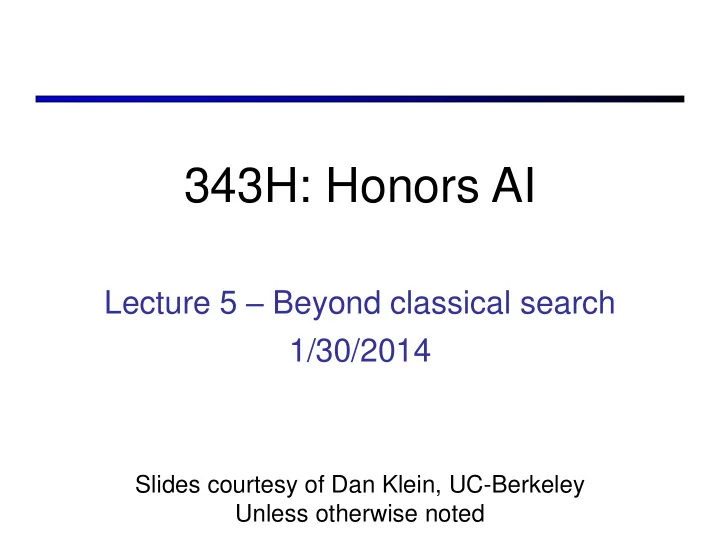

343H: Honors AI Lecture 5 – Beyond classical search 1/30/2014 Slides courtesy of Dan Klein, UC-Berkeley Unless otherwise noted
Today Review of A* and admissibility Graph search Consistent heuristics Local search Hill climbing Simulated annealing Genetic algorithms Continuous search spaces
Recall: A* Search Uniform-cost orders by path cost, or backward cost g(n) Greedy orders by goal proximity, or forward cost h(n) 5 h=1 e 1 1 3 2 S a d G h=6 h=5 1 h=2 h=0 1 c b h=7 h=6 A* Search orders by the sum: f(n) = g(n) + h(n) Example: Teg Grenager
Recall: Creating Admissible Heuristics Most of the work in solving hard search problems optimally is in coming up with admissible heuristics Often, admissible heuristics are solutions to relaxed problems, where new actions are available 366 15 Inadmissible heuristics are often useful too (why?)
Generating heuristics How about using the actual cost as a heuristic? Would it be admissible? Would we save on nodes expanded? What’s wrong with it? With A*: a trade-off between quality of estimate and work per node!
Trivial Heuristics, Dominance Dominance: h a ≥ h c if Heuristics form a semi-lattice: Max of admissible heuristics is admissible Trivial heuristics Bottom of lattice is the zero heuristic (what does this give us?) Top of lattice is the exact heuristic
Tree Search: Extra Work! Failure to detect repeated states can cause exponentially more work. Why? Search tree State graph
Graph Search In BFS, for example, we shouldn’t bother expanding the circled nodes (why?) S e p d q e h r b c h r p q f a a q c p q f G a q c G a
Graph Search Idea: never expand a state twice How to implement: Tree search + set of expanded states (“closed set”) Expand the search tree node-by- node, but… Before expanding a node, check to make sure its state is new If not new, skip it Important: store the closed set as a set, not a list Can graph search wreck completeness? Why/why not? How about optimality? Warning: 3e book has a more complex, but also correct, variant
A* Graph Search Gone Wrong? State space graph Search tree S (0+2) A 1 1 h=4 S A (1+4) B (1+1) C h=1 1 h=2 2 C (2+1) C (3+1) 3 B G (5+0) G (6+0) h=1 G h=0
Consistency of Heuristics Admissibility: heuristic cost <= A actual cost to goal 1 h=4 h(A) <= actual cost from A to G C 3 G
Consistency of Heuristics Stronger than admissibility A Definition: 1 h=4 C heuristic cost <= actual cost per arc h=2 h=1 h(A) - h(C) <= cost(A to C) Consequences: The f value along a path never decreases A* graph search is optimal
Optimality Tree search: A* is optimal if heuristic is admissible (and non-negative) UCS is a special case (h = 0) Graph search: A* optimal if heuristic is consistent UCS optimal (h = 0 is consistent) Consistency implies admissibility In general, most natural admissible heuristics tend to be consistent, especially if from relaxed problems
Summary: A* A* uses both backward costs and (estimates of) forward costs A* is optimal with admissible / consistent heuristics Heuristic design is key: often use relaxed problems
Today Review of A* and admissibility Graph search Consistent heuristics Local search Hill climbing Simulated annealing Genetic algorithms Continuous search spaces
Local Search Methods Tree search keeps unexplored alternatives on the fringe (ensures completeness) Local search: improve what you have until you can’t make it better Tradeoff: Generally much faster and more memory efficient (but incomplete)
Types of Search Problems Planning problems: We want a path to a solution (examples?) Usually want an optimal path Incremental formulations Identification problems: We actually just want to know what the goal is (examples?) Usually want an optimal goal Complete-state formulations Iterative improvement algorithms
Hill Climbing Simple, general idea: Start wherever Always choose the best neighbor If no neighbors have better scores than current, quit Why can this be a terrible idea? Complete? Optimal? What’s good about it?
Hill Climbing Diagram Sideways steps? Random restarts?
Quiz Hill climbing on this graph:
Hill climbing Mona Lisa Could the computer paint a replica of the Mona Lisa using only 50 semi transparent polygons? http://rogeralsing.com/2008/12/07/genetic-programming-evolution-of-mona-lisa/
Simulated Annealing Idea: Escape local maxima by allowing downhill moves But make them rarer as time goes on
Beam Search Like greedy hillclimbing search, but keep K states at all times: Greedy Search Beam Search Variables: beam size, encourage diversity? The best choice in many practical settings
Genetic Algorithms Genetic algorithms use a natural selection metaphor Like beam search (selection), but also have pairwise crossover operators, with optional mutation
Example: N-Queens Why does crossover make sense here? When wouldn’t it make sense? What would mutation be? What would a good fitness function be?
Continuous Problems Placing airports in Romania States: (x 1 ,y 1 ,x 2 ,y 2 ,x 3 ,y 3 ) Cost: sum of squared distances to closest city 26
Gradient Methods How to deal with continous (therefore infinite) state spaces? Discretization: bucket ranges of values E.g. force integral coordinates Continuous optimization E.g. gradient ascent Image from vias.org 27
Example: Continuous local search Slide credit: Peter Stone
A parameterized walk Trot gait with elliptical locus on each leg 12 continuous parameters (ellipse length, height, position, body height, etc) Slide credit: Peter Stone
Experimental setup
Policy gradient reinforcement learning Slide credit: Peter Stone
Summary Graph search Keep closed set, avoid redundant work A* graph search Optimal if h is consistent Local search: Improve current state Avoid local min traps (simulated annealing, crossover, beam search)
Recommend
More recommend